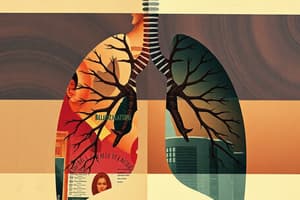Podcast
Questions and Answers
What function does the epiglottis serve during swallowing?
What function does the epiglottis serve during swallowing?
- Divides the trachea into bronchi
- Supports the structure of the lungs
- Prevents food from entering the larynx (correct)
- Helps produce sound
What structure branches from the trachea to enter each lung?
What structure branches from the trachea to enter each lung?
- Bronchioles
- Pharynx
- Bronchi (correct)
- Alveoli
What is the main function of the pleural fluid found between the layers of pleura?
What is the main function of the pleural fluid found between the layers of pleura?
- To aid in sound production
- To hold the bronchi in place
- To carry oxygen to the blood
- To reduce friction on the lung surface (correct)
Which section of the respiratory system acts as a common passage for both food and air?
Which section of the respiratory system acts as a common passage for both food and air?
What is the primary function of the alveoli in the respiratory system?
What is the primary function of the alveoli in the respiratory system?
How do lower invertebrates primarily exchange gases?
How do lower invertebrates primarily exchange gases?
Which group of animals primarily uses gills for respiration?
Which group of animals primarily uses gills for respiration?
What structure prevents food from entering the windpipe in humans?
What structure prevents food from entering the windpipe in humans?
What are the tiny air sacs called where gas exchange occurs in the human lungs?
What are the tiny air sacs called where gas exchange occurs in the human lungs?
What type of respiration involves the moist skin in amphibians like frogs?
What type of respiration involves the moist skin in amphibians like frogs?
Which of the following is NOT a component of the human respiratory system?
Which of the following is NOT a component of the human respiratory system?
What is the primary function of the pleural fluid in the thoracic cavity?
What is the primary function of the pleural fluid in the thoracic cavity?
Which of the following structures undergoes repeated divisions to form bronchioles in humans?
Which of the following structures undergoes repeated divisions to form bronchioles in humans?
Study Notes
Respiratory Organs Overview
- Breathing mechanisms vary across animal groups, influenced by habitat and organizational complexity.
- Lower invertebrates (e.g., sponges, flatworms) exchange gases through simple diffusion across their body surfaces.
- Earthworms utilize a moist cuticle for gas exchange, while insects employ a tracheal tube system.
- Aquatic organisms like arthropods and mollusks use gills for branchial respiration.
- Terrestrial animals use lungs (pulmonary respiration) for gas exchange.
- Among vertebrates, fishes respire using gills, while amphibians, reptiles, birds, and mammals utilize lungs.
- Frogs and other amphibians can also respire through their skin (cutaneous respiration).
Human Respiratory System
- Humans possess external nostrils that lead to a nasal chamber, allowing air entry.
- The nasal chamber connects to the pharynx, which serves as a common pathway for food and air.
- The pharynx is a cartilaginous tube, extending to the trachea.
- The larynx, referred to as the "sound box," is a cartilaginous structure essential for sound production and is protected by the epiglottis.
- The epiglottis prevents food from entering the windpipe during swallowing.
- The trachea is a straight tube that descends into the thorax and bifurcates into a right and left primary bronchus.
- Each bronchus divides into secondary and tertiary bronchi, eventually leading to thin terminal bronchioles.
- Incomplete cartilaginous rings support the trachea and bronchi.
- Terminal bronchioles branch into alveoli, which are small, vascularized, bag-like structures responsible for gas exchange.
- Humans have two lungs located in the thoracic cavity, covered by a double-layered pleura that contains pleural fluid to reduce friction.
- The outer pleural membrane is closely attached to the thoracic cavity.
Studying That Suits You
Use AI to generate personalized quizzes and flashcards to suit your learning preferences.
Description
Explore the diverse mechanisms of breathing in various organisms as presented in Chapter 17. Understand how respiratory organs adapt to different habitats, including the unique systems in lower invertebrates and insects. This quiz will challenge your knowledge of gas exchange processes.





